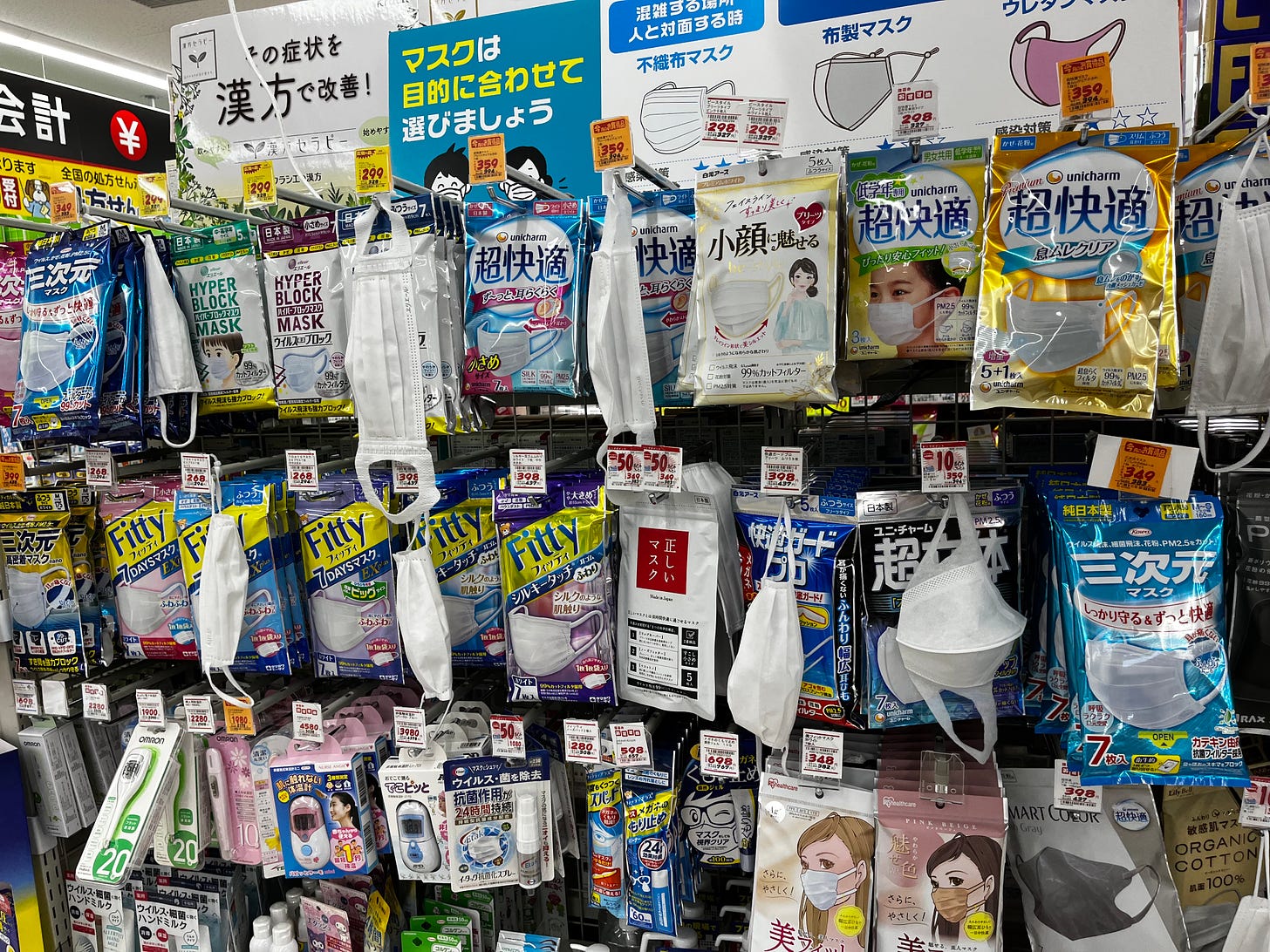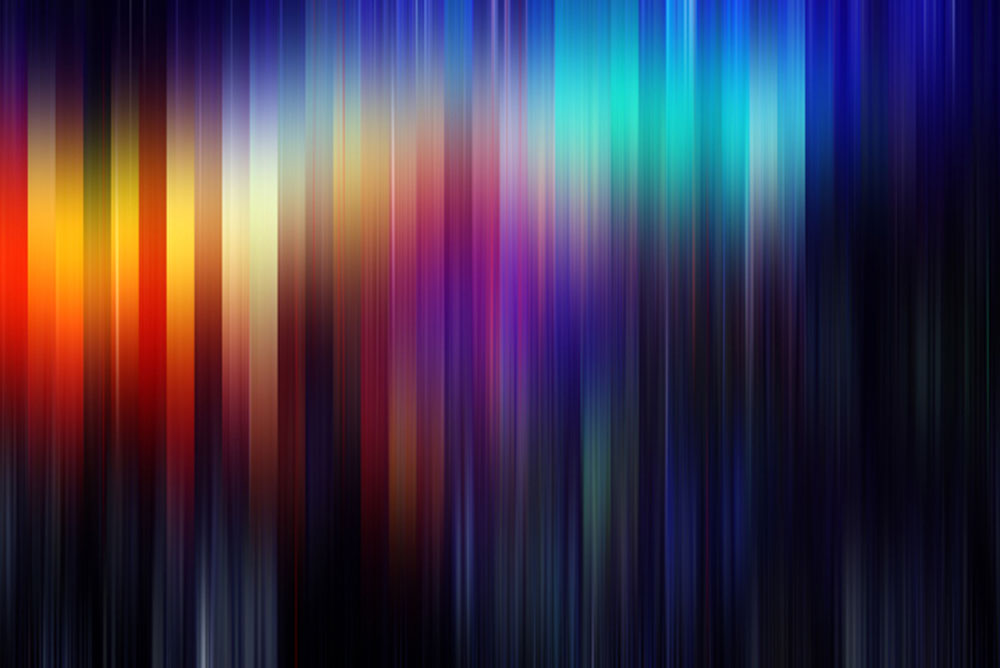By Valerie Monroe
If you’re interested in feeling happier about your appearance—especially as you age—you might like reading what she has to say about it. For more of her philosophical and practical advice, subscribe for free to How Not to F*ck Up Your Face at valeriemonroe.substack.com.
SOME OF MY favorite places to visit in Tokyo are drugstores, where there’s a phantasmagoria of options for just about any hair, skin, nail, or dental issue you could imagine. I don’t speak Japanese, so my purchases are often accompanied by a kind of Charades. They can occasionally be challenging, like when I wanted to be sure the extra-large fizzing tablets I was buying were for cleaning a night guard rather than a toilet bowl. (They were—but I still wonder if they had been toilet-friendly, what the nice clerk would’ve thought about why I was aggressively pointing to my mouth.)

Masks, obviously, but not even half of the kaleidoscopic selection! / Photo by Valerie Monroe.
On the topic of phantasmagoric options, a few illuminating words about light therapy. It can make your head spin to consider the many, many different kinds touted to benefit the skin. And because one reader (thank you, Ann B.) has persistently inquired about whether the red-light therapy recently promoted by an unreliable source can also brighten skin and reduce fine lines and wrinkles, I asked dermatologist Laurel Naversen Geraghty, who generously shared her time and wisdom, for the lowdown.
Geraghty pointed out that red-light therapy sneakily operates under a few aliases: photobiomodulation, low-level laser light, LED therapy, cold-laser therapy, biostimulation, phototherapy, and more. Studies of varying reliability back up claims that red-light therapies offer such potential benefits as reducing pre-cancers, inflammation, and wrinkles; calming acne; and healing wounds. Based on current research, Geraghty says red-light therapy probably does have some potentially beneficial effects on the skin. But significantly more research is needed to understand what results one can expect, which skin conditions may respond to it, which types of red-light devices are most effective, at what intensity they must be used, and how many treatments are needed to see a benefit (especially regarding relatively gentle red-light devices for at-home use). The bottom-line question Geraghty (in a playful, summertime mood) shot back to me: Why waste time on a puny squirt gun when a super-soaker does the job faster and better? Because there’s a roster of other in-office treatments that are supported by stronger evidence and deliver much more visible results more quickly.
The one exception Geraghty notes is red- or blue-light therapy used to target, treat, and prevent pre-cancers of the skin, effectively reversing and removing sun damage. It’s called photodynamic therapy in which a topical—Levulan (or aminolevulinic acid)—is applied to the skin and left on for an hour or more prior to light exposure for approximately 17 minutes. Note that the combination of the acid with the lights is key. I had this treatment about six months ago and was extremely happy with the improved texture of my skin; in fact, I can’t think of another treatment I’ve been happier with. (An added benefit: The treatment is covered by some insurance, including Medicare.)
As for other in-office treatments maybe worth opening up your wallet for? Geraghty recommends IPL (intense pulsed light), which she calls a workhorse for fair-skin types, especially the freckle-prone. IPL can help reduce facial blood vessels, sunspots, and melasma; even out skin tone; and remove visible signs of sun damage, all without significant downtime. A single treatment can make a visible difference; three sessions have the potential to transform the look of your skin. I’ve had several IPL treatments and was pleased that it seemed to reduce redness and even out my skin tone.
More richly pigmented skin types do well with rejuvenating lasers, such as the 1064 Nd:Yag and the PicoToning laser, says Geraghty. These can rejuvenate skin, stimulate collagen, and help remove spots or dyspigmentation in a safe way, and healing tends to be rapid. I’ve had several similar Pico laser treatments, too, and was pleased with the brightening I saw afterward. (Meaning my skin looked better somehow; more uniform coloration, mostly.)
In olive- or darker-toned complexions, there’s a higher risk of dyspigmentation and other side effects from laser and light therapies; Geraghty emphasizes that these kinds of treatments should be performed by a well-trained dermatologist or a provider who works under the guidance of one.
Finally, radio-frequency microneedling is an excellent and relatively new therapy for stimulating collagen, tightening skin, reducing wrinkles, and generally softening signs of aging—without a lot of pain or downtime. I recently had this treatment on my lower face and neck (thank you, dermatologist Estee Williams) and am curious to see if I’ll notice an effect in my skin’s quality.
As Geraghty points out, it can be really hard to know which treatments will be the most efficacious for you. But you don’t need to play Charades. If you choose a doctor who’s well educated about the many light, laser, and energy-based therapies available, you’re more likely to have a treatment (or a series of treatments) customized to your unique situation and desires. And please, friends: Never forget to do your exercises.
MyLittleBird often includes links to products we write about. Our editorial choices are made independently; nonetheless, a purchase made through such a link can sometimes result in MyLittleBird receiving a commission on the sale. We are also an Amazon Associate.


